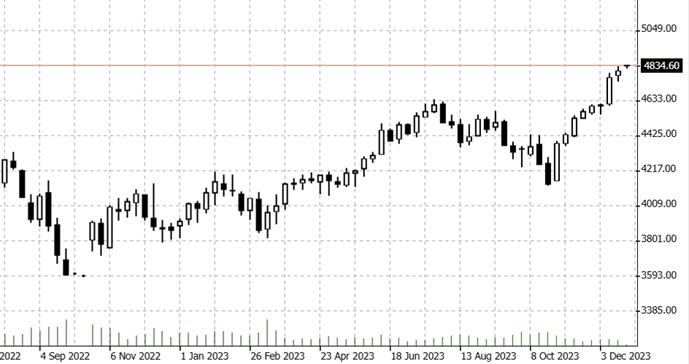

16.01.2024 – If some augurs are right, then the market will soon be flooded with fresh money again. In other words, the Federal Reserve’s quantitative tightening is apparently about to come to an end. At the very least, it is likely to be slowed down. The reason is apparently liquidity problems in the interbank market.
The Federal Reserve’s presumed about-turn could give the market a new boost. This is because a large wave of money is likely to flow back into Wall Street and the real economy. That would be the consequences: Equities long, dollar short, precious metals long, just like other commodities. The picture shows an example of the daily chart of the S&P 500.

Source: Bernstein Bank GmbH
This is the background: The brilliant financial blog “ZeroHedge” once again referred to a development that is said to have started back in December. According to the blog, the interbank market is the canary that has just tipped off the perch – the SOFR (Secured Overnight Financing Rate) reached its highest level since the repo crisis in March 2020 weeks ago. In other words, banks urgently need fresh money and are therefore prepared to pay higher interest rates in overnight lending. The Fed’s quantitative tightening has dried up the available liquidity, as Lorie Logan, head of the Dallas Fed, also recently stated.
Signals from WSJ and JPM
And now the mouthpiece of Fed Chairman Jerome Powell has also spoken out. Nick Timiraos from the “Wall Street Journal” confirmed that QT will be curbed: “Fed officials are to start deliberations on slowing, though not ending, that so-called quantitative tightening as soon as their policy meeting this month. It could have important implications for financial markets.”
As luck would have it, JP Morgan made a similar judgement: “We now expect that the FOMC will have the outline of a timeline at the January meeting, communicated mid-February minutes to that meeting. We expect that this plan will be formally agreed to at the mid-March meeting and will be implemented beginning in April.” In other words, the previous monthly reduction in available Treasuries will be lowered from USD 60 billion to USD 30 billion from this date at the latest – in the course of tightening, the Fed has allowed bonds and mortgages to expire without replacing them with new ones.
Our conclusion: If the tightening is reduced, the bulls can rejoice. Especially as interest rate cuts are also possible. However, there is one important caveat: if investors start to worry that any major banks are reeling, things will get uncomfortable. Much will depend on the Fed’s wording, i.e. the justification for the renewed increase in liquidity. We look forward to seeing what happens next and will keep you up to date!
_______________________________________________________________________________________________________________________________________________
The content of this publication is for general information purposes only. In this context, it is neither an individual investment recommendation or advice nor an offer to purchase or sell securities or other financial products. The content in question and all the information contained therein do not in any way replace individual investor- or investment-oriented advice. No reliable forecast or indication for the future is possible with respect to any presentation or information on the present or past performance of the relevant underlying assets. All information and data presented in this publication are based on reliable sources. However, Bernstein Bank does not guarantee that the information and data contained in this publication is up-to-date, correct and complete. Securities traded on the financial markets are subject to price fluctuations. A contract for difference (CFD) is also a financial instrument with leverage effect. Against this backdrop, CFD trading involves a high risk up to the point of total loss and may not be suitable for all investors. Therefore, make sure that you have fully understood all the correlating risks. If necessary, ask for independent advice. CFDs are complex instruments and are associated with the high risk of losing money quickly because of the leverage effect. 68% of retail investor accounts lose money trading CFD with this provider. You should consider whether you understand how CFD work and whether you can afford to take the high risk of losing your money.7
